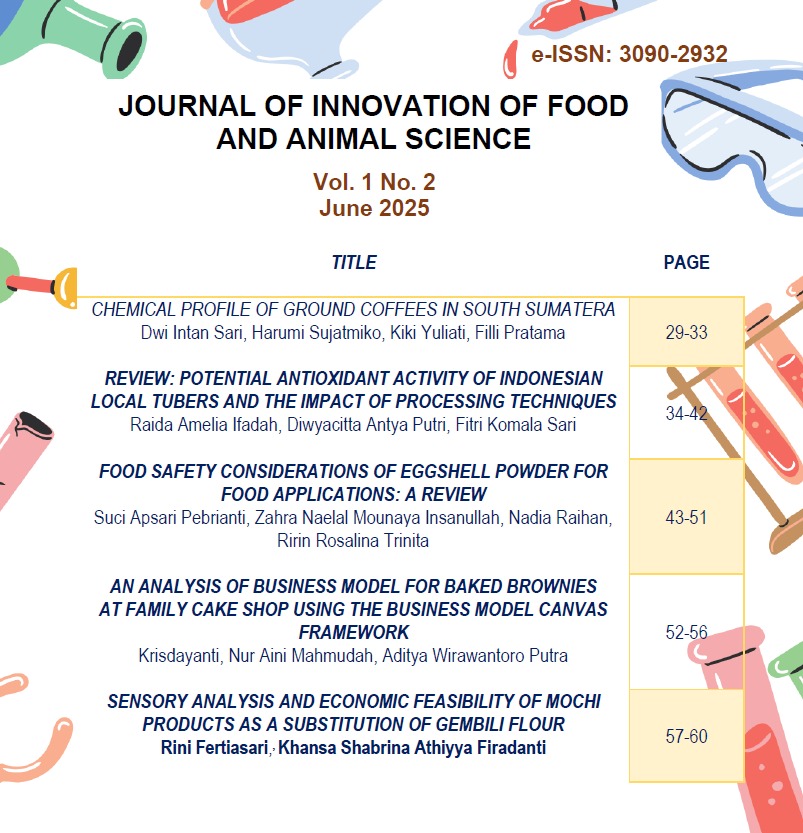REVIEW : POTENTIAL ANTIOXIDANT ACTIVITY OF INDONESIAN LOCAL TUBERS AND THE IMPACT OF PROCESSING TECHNIQUES
 Abstract views: 201
,
Abstract views: 201
,
 PDF downloads: 74
PDF downloads: 74
Abstract
Indonesia is endowed with a wide diversity of local tubers that hold untapped potential as functional food sources. Tubers such as purple and orange sweet potatoes, taro (Colocasia esculenta), yam (Dioscorea spp.), gadung (Dioscorea hispida), suweg (Amorphophallus paeoniifolius), and gembili (Dioscorea esculenta) are rich in phytochemicals such as flavonoids, phenolic acids, anthocyanins, and carotenoids. These compounds exhibit strong antioxidant activities which are linked to their capability to scavenge free radicals, thus potentially preventing oxidative stress-related diseases. However, the bioactivity and stability of these antioxidants are significantly influenced by food processing techniques. Thermal treatments such as boiling, steaming, and baking may degrade thermolabile compounds like anthocyanins, while other processes such as fermentation and ultrasonic-assisted extraction have been shown to increase the extractability and bioavailability of phenolic compounds. This review compiles and analyzes recent scientific findings on antioxidant content in local Indonesian tubers and evaluates how various processing methods affect their efficacy. Furthermore, it discusses the relevance of these findings for the development of functional foods and nutraceuticals based on indigenous crops.
References
Brand-Williams, W., Cuvelier, M. E., & Berset, C. 1995. Use of a free radical method to evaluate antioxidant activity. LWT - Food Science and Technology, 28(1), 25–30. https://doi.org/10.1016/S0023-6438(95)80008-5
Chemat, F., Rombaut, N., Sicaire, A. G., Meullemiestre, A., Fabiano-Tixier, A. S., & Abert-Vian, M. 2017. Ultrasound-assisted extraction of food and natural products: mechanisms, techniques, combinations, protocols and applications – a review. Ultrasonics Sonochemistry, 34, 540–560. https://doi.org/10.1016/j.ultsonch.2016.06.035
Czank, C., Cassidy, A., Zhang, Q., Morrison, D. J., Preston, T., Kroon, P. A., et al. 2013. Human metabolism and elimination of the anthocyanin, cyanidin-3-glucoside: a 13C-tracer study. The American Journal of Clinical Nutrition, 97(5), 995–1003. https://doi.org/10.3945/ajcn.112.049247
Firman, D., Nurhaeni, Ridhay, A. 2016. Rahmayani, D., Khairani, R. D., & Wulandari, R. 2021. Aktivitas antioksidan ekstrak umbi suweg (Amorphophallus paeoniifolius) dari berbagai tingkat polaritas pelarut. Jurnal Riset Kimia, 2(1), 61–69.
Fitriansyah, F. 2023. Kandungan kimia dan aktivitas antioksidan pada umbi bawang dayak hasil fermentasi. Jurnal Sains dan Teknologi Farmasi Indonesia, 8(1), 22–29.
Franková H, Musilová J, Árvay J, Šnirc M, Jančo I, Lidiková J, Vollmannová A. 2022. Changes in antioxidant properties and phenolics in sweet potatoes (Ipomoea batatas L.) due to heat treatments. Molecules. 14;27(6):1884. https://doi.org/10.3390/molecules27061884
Haryoto, H., Riyadini, M. P., Muhtadi, M., Wibowo, A. 2023. Antioxidant activity of ethanolic extracts of purple and orange sweet potatoes (Ipomoea batatas L.). Science Letters 17(1). 121-131.
Hur, S. J., Lee, S. Y., Kim, Y. C., Choi, I., & Kim, G. B. 2014. Effect of fermentation on the antioxidant activity in plant-based foods. Food Chemistry, 160, 346–356. https://doi.org/10.1016/j.foodchem.2014.03.112
Laurie, S. M., Faber, M., & Claasen, N. 2012. Incorporating orange-fleshed sweet potato into the food system as a strategy for improved nutrition: the context and experiences of South Africa. Food Research International*, 44(1), 29–37. https://doi.org/10.1016/j.foodres.2011.02.002
Pham-Huy, L. A., He, H., & Pham-Huy, C. 2008. Free radicals, antioxidants in disease and health. International Journal of Biomedical Science, 4(2), 89–96.
Prayoga, M. R., Munar, A., Mirad, R. B. 2025. Morphological identification and evaluation of phytochemical content and antioxidant activity of gembili tuber (Dioscorea esculenta L.) in Malaysia. Jurnal Agronomi Tanaman Tropika (JUANTIKA) 7(2), 490-494.
Raju, J., & Bird, R. P. 2006. Alleviation of hepatic steatosis accompanied by modulation of plasma and liver TNF-α levels by diosgenin in ob/ob mice. Obesity, 14(8), 1328–1335. https://doi.org/10.1038/oby.2006.150
Rizkia, P., Jannah, A., Hasanah, H. 2014. Uji efektivitas antioksidan ekstrak etanol 70%, ekstrak dan isolat senyawa flavonoid dalam umbi binahong (Anredera cordifolia (Ten.) Steenis). ALCHEMY: Journal of Chemistry, 1(1), 25–30.
Rodríguez-Amaya, D. B. 2015. Food carotenoids: chemistry, biology and technology. John Wiley & Sons.
Purwaningsih, I., Yuanti, J., Ratnawati, G. J. 2020. Uji aktivitas antioksidan ekstrak etanol umbi talas (Colocasia esculenta (L) Schott) Metode Dpph (2,2-diphenyl-1-picrylhydrazil). Jurnal Laboratorium Khatulistiwa 4(1), 13-21.
Shahidi, F., & Ambigaipalan, P. 2015. Phenolics and polyphenolics in foods, beverages and spices: antioxidant activity and health effects–a review. Journal of Functional Foods, 18, 820–897. https://doi.org/10.1016/j.jff.2015.06.018
Shahidi, F., & Zhong, Y. 2010. Novel antioxidants in food quality preservation and health promotion. European Journal of Lipid Science and Technology, 112(9), 930–940. https://doi.org/10.1002/ejlt.201000044
Susanti, S., Fadilah, N. N., & Rizkuloh, L. R. 2022. Ekstraksi berbantu ultrasonic dan aktivitas antioksidan ekstrak umbi gadung (Dioscorea hispida) secara in vitro. Jurnal Ilmiah Farmako Bahari, 13(1), 55–62.
Wang, L. S., & Stoner, G. D. 2008. Anthocyanins and their role in cancer prevention. Cancer Lett, 269(2), 281–290. https://doi.org/10.1016/j.canlet.2008.05.020



